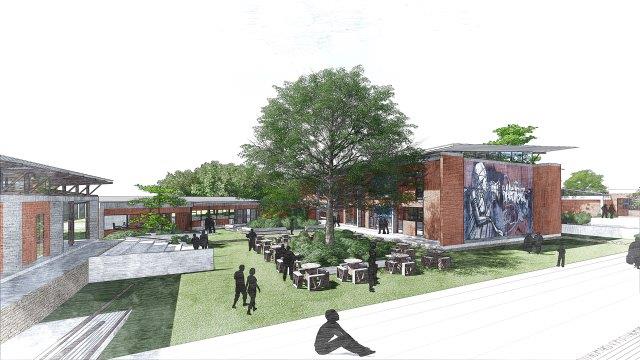
Looking at how architecture can contribute to existing learning environments by integrating community influence within rural primary schools resulted in Neeshailin Naicker being declared the regional winner from the University of KwaZulu-Natal as part of the 34th Corobrik Architectural Student of the Year Awards.
In exploring how to promote quality education in rural communities by using alternative methods of teaching and learning based on community influence, Neeshailin’s winning thesis proposed a building design that defines the principles for a spatial rethink of a primary school in rural KwaZulu-Natal. The aim is to extend the conventional learning experience beyond the confines of constructed classroom spaces to the broader context of learning in place, and simultaneously providing an opportunity for community empowerment.
Billed as one of the most prestigious awards programmes of its kind in South Africa, the Corobrik Architectural Student of the Year Awards selects regional winners from eight major universities, based on the students’ final theses. These regional winners then go through to the national round, where the top title is awarded, in addition to a R70 000 grand prize.
“I am extremely honoured and grateful to be competing in the finals of such a prestigious competition. I never imagined myself being in this sort of position, so I am really looking forward to this experience, which will only aid in the growth of my architecture career,” comments Neeshailin. “To be honest, it is still sinking in that I was the winner. There was stiff competition from the rest of my classmates.”
Neeshailin adds: “I think it is vitally important for companies like Corobrik to host awards like this, as it provides an important platform for students to showcase their potential and gives them exposure and opportunities they would not likely be able to access otherwise.” The use of Corobrik products was a natural choice for his design, as the product provided the most efficient and sustainable outcomes to the overall construction and aesthetic of the building.
From an architectural perspective, Neeshailin has been motivated by exploring the vital relationship between communities, education and the built environment to contribute to resolving existing problems found in rural architecture. The design provides for a much more considered architectural approach that responds not only to the pedagogical needs of the students, but also to the socioeconomic needs of the rural community, which is a major asset to its holistic sustainability.
“I am passionate about education and its power to change a person’s life. Thus, architecturally I would like to provide my local community with contextually-responsive education facilities that will enable them to empower themselves and achieve their full potential,” highlights Neeshailin. “My dream is to one day have an architectural firm of my own that is heavily involved in community-based upliftment projects.”
Kirsten Harrington won the category of ‘Best Use of Clay Masonry’ for a thesis that focused on the importance of adapting derelict and underutilised buildings to better suit the changing needs of existing communities. The project grew from the lack of job opportunities and necessary resources for skilled artisans within the South Beach area in Durban, where the urban environment has slowly deteriorated.
In hope of mobilising the deprived and alienated local community, Kirsten looked to adapt an existing building within the area known as The Wheel. The building is currently underutilised and closed off from its street edges, having one entrance that climbs three floors of parking. It is proposed that the so-called African Artisan Trade Centre has a set-back façade to allow for a forecourt for informal trade and community engagement that the road currently lacks.
In addition, the ground floor will break away through a landscape of steps and ramps integrated with platforms, seating and planting. This will allow for an array of empowering spaces that service the needs and wants of the local community. The idea to use brick arose from exposing the red clay brick of the existing structure. “I then wanted to play on the idea of adaptability through creating a brise soleil system as the building’s second skin,” explains Kirsten. The system allows for a play of light and varying degrees of privacy.
Commenting on the importance of such awards, Kirsten adds: “This platform allows students to showcase their work and to be recognised for their creativity and innovative ideas. Competitions like these encourages students to think big and opens doors to new possibilities. I am extremely appreciative to have been a part of such a large platform.”
Corobrik has long played a pivotal role in recognising up-and-coming young architects in South Africa, notes Marketing Support Manager Thilo Sidambaram, who herself has been involved with the awards for two decades. The Covid-19 pandemic has meant that most regional and national events have had to be held remotely. “Despite the challenges posed, the country’s architectural students have still managed to excel, and Corobrik is proud to continue to support our universities during this difficult period.”
34th Corobrik Architectural Student of the Year Awards: UKZN
Winner Neeshailin Naicker R10 000
1st Runner-Up Adrian Govender R8 000
2nd Runner-Up Neshay Sirbadhoo R6 000
Best Use of Clay Masonry Kristen Harrington R6 000
Look out for the National Corobrik Student of the Year Awards ceremony that will take place virtually in May.
More news
- PART 2: DESIGN AND CONSTRUCTION OF SLAB-ON-GROUND: APPLYING ACI 318
- DESIGN AND CONSTRUCTION OF SLAB-ON-GROUND: APPLYING ACI 318
- DOK-ING’s innovative electric mining equipment unveiled at ElectraMining
- CONCOR’S MASTERY IN FAST TRACK PROJECT IMPLEMENTATION UNDERSCORED BY SAFETY AWARD
- PROMINENT SEA POINT HOTEL REFURBS WITH REHAU

